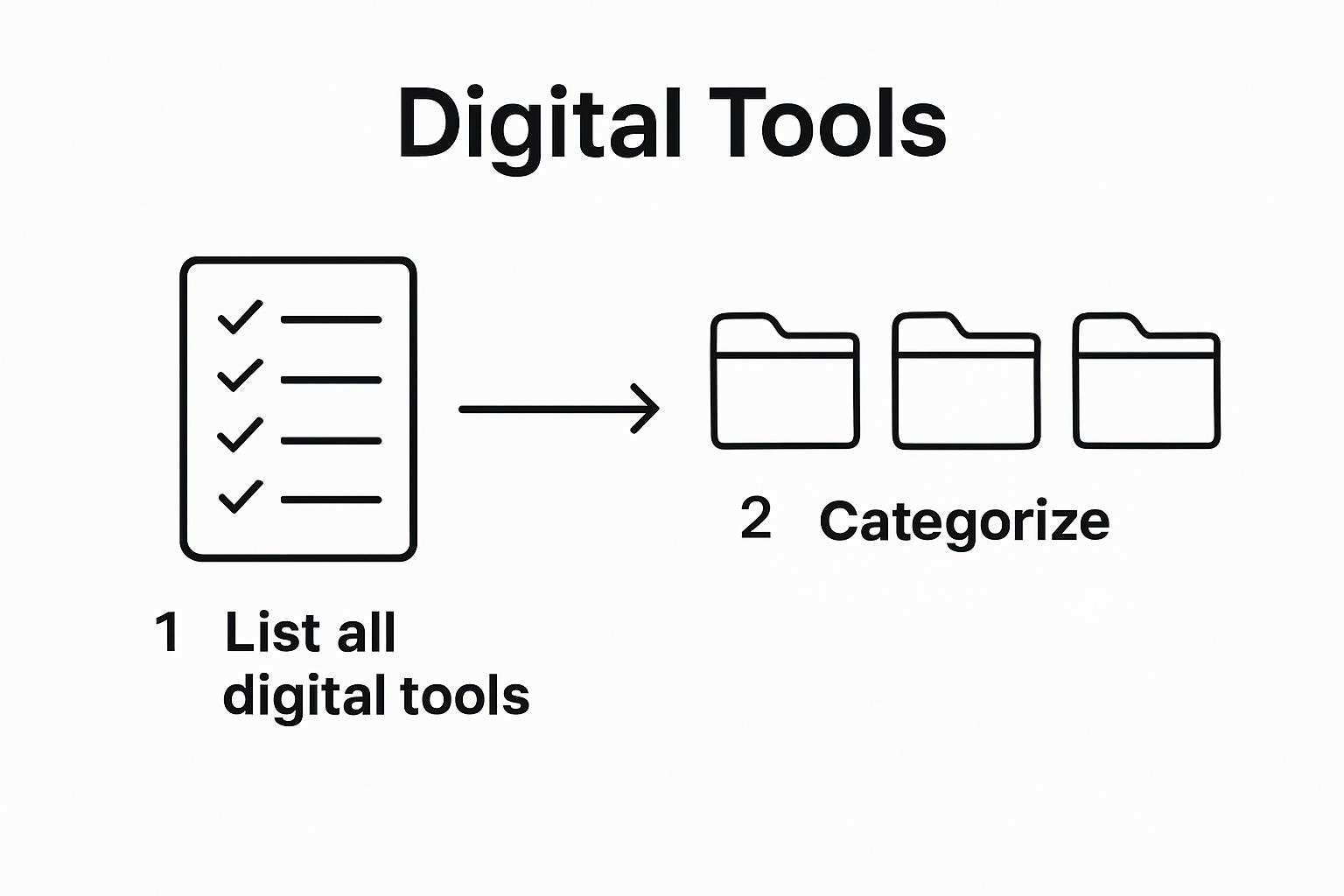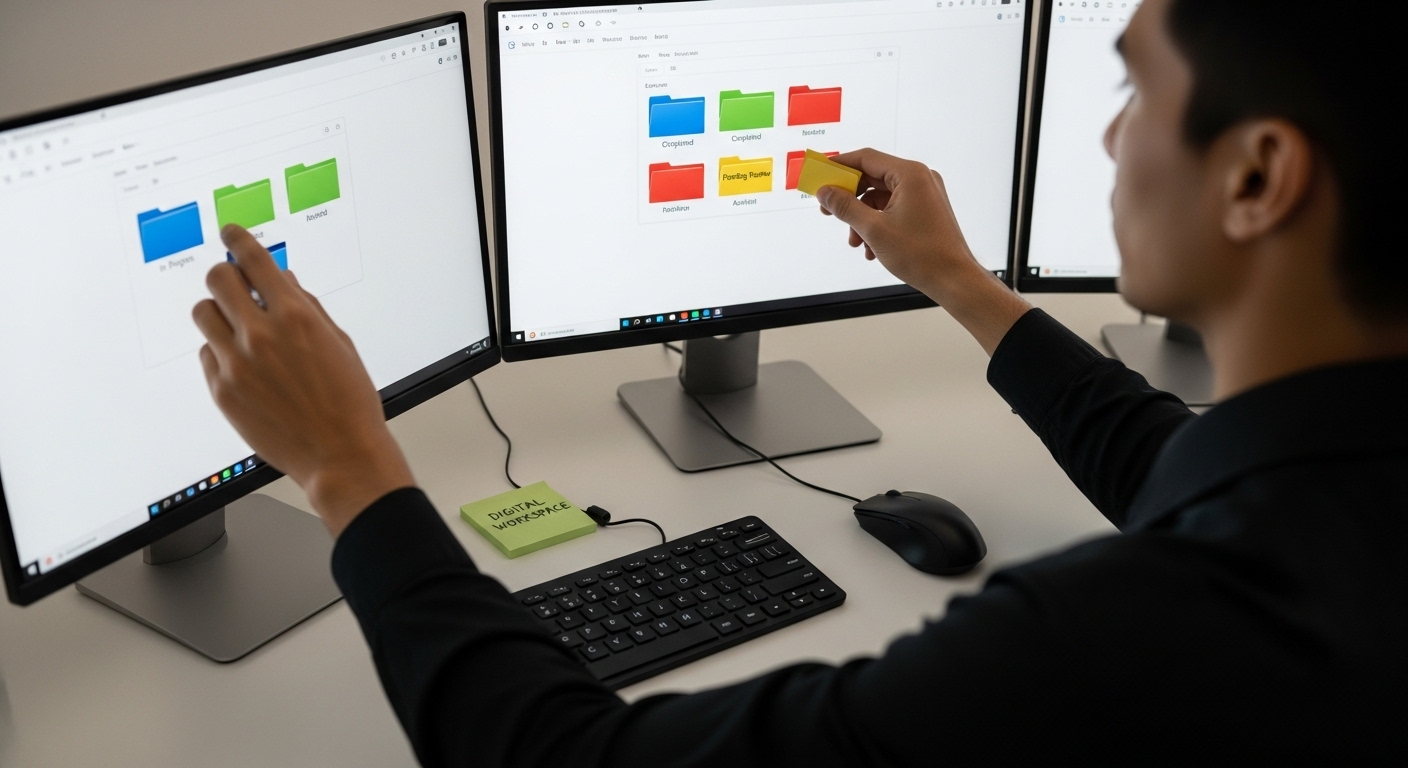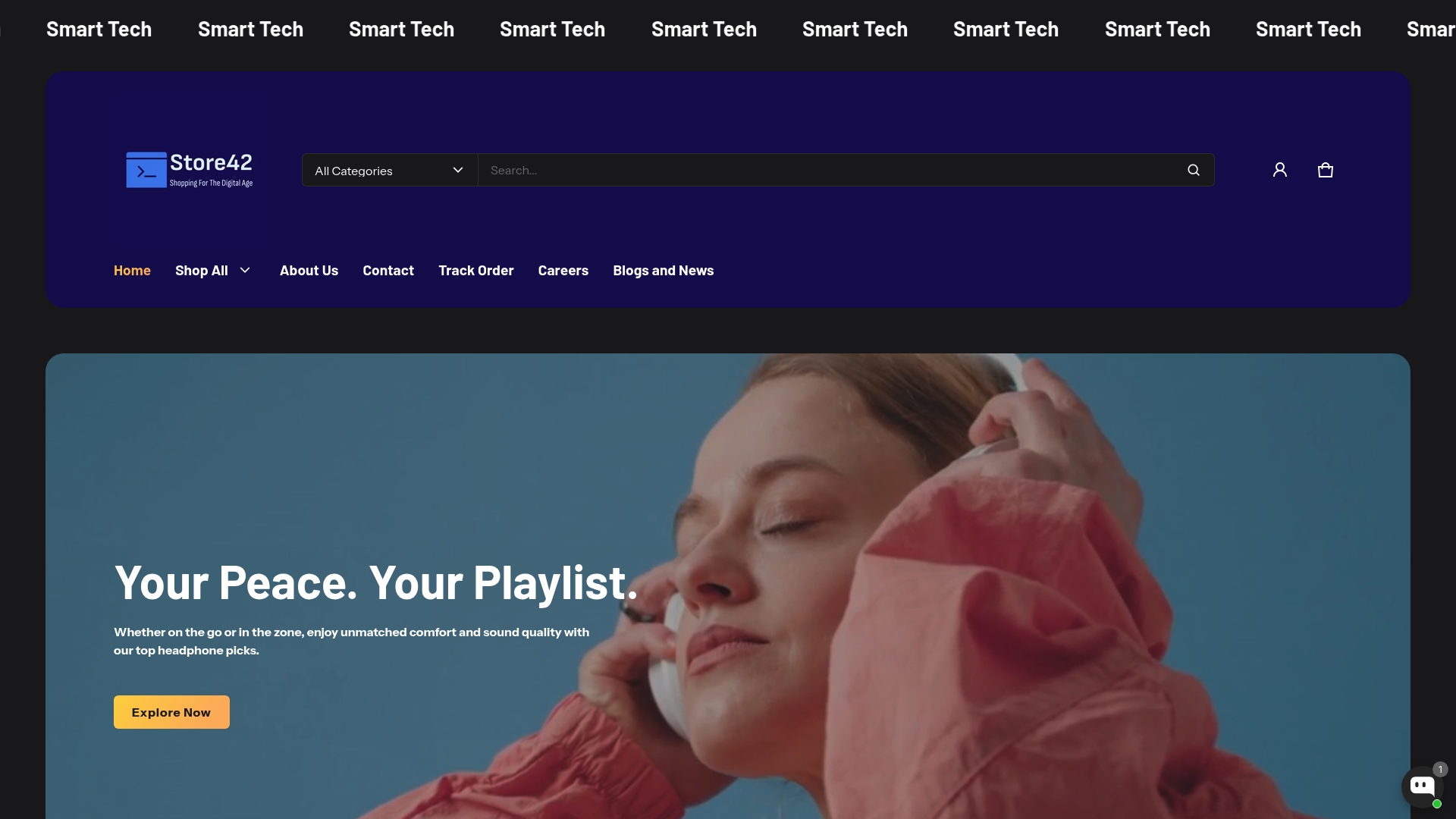Digital tools are supposed to make life easier and work smoother for professionals everywhere. Yet over 70 percent of people admit they own apps and subscriptions they rarely even use. That is only part of the story. The real transformation comes when you learn to assess, trim, and organize your digital workspace and habits so well that productivity jumps in ways you did not expect.
Table of Contents
- Step 1: Assess Your Current Digital Tools And Habits
- Step 2: Identify Time-Wasting Activities And Set Goals
- Step 3: Organize Your Digital Workspace Effectively
- Step 4: Implement Productivity Tools And Apps
- Step 5: Establish A Routine And Minimize Distractions
- Step 6: Monitor Progress And Adjust Strategies Regularly
Quick Summary
| Key Point | Explanation |
|---|---|
| 1. Conduct a digital tool inventory | List all tools you use and evaluate their effectiveness and utility to streamline your digital workflow. |
| 2. Set measurable productivity goals | Define specific, actionable goals based on time-tracking insights to effectively remove distractions. |
| 3. Organize your digital workspace | Create a systematic file structure to enhance navigation and reduce time spent searching for documents. |
| 4. Implement a personalized routine | Develop a routine that incorporates focus strategies and minimizes distractions to support consistent productivity. |
| 5. Regularly monitor and adapt strategies | Continuously assess your productivity metrics and make adjustments to improve efficiency and effectiveness. |
Step 1: Assess Your Current Digital Tools and Habits
Booting digital productivity starts with honest self-evaluation. Modern professionals often accumulate digital tools and workflows without critically examining their actual effectiveness. Your goal in this initial step is to create a comprehensive snapshot of your current digital ecosystem, identifying both strengths and inefficiencies that might be secretly undermining your professional performance.
Begin by conducting a thorough inventory of every digital tool, application, and platform you currently use for work. Write down each tool’s purpose, frequency of use, and your personal satisfaction level. This process requires brutal honesty and careful reflection. Most professionals discover they’re using multiple tools with overlapping functionalities or maintaining subscriptions to services they rarely utilize.
As you map out your digital workflow, pay special attention to communication platforms, project management software, note-taking applications, cloud storage solutions, and productivity trackers. Consider creating a simple spreadsheet categorizing these tools into essential, occasionally useful, and unnecessary categories. This systematic approach helps you visualize your digital landscape and identify potential redundancies.

Critical assessment metrics should include:
- Time spent learning/maintaining each tool
- Actual productivity gains from the tool
- Integration capabilities with other platforms
- Cost versus return on investment
- Personal comfort and ease of use
If you find yourself juggling multiple task management apps or struggling to remember which platform hosts which project, it might signal that your digital toolkit needs streamlining. Check out our guide on mastering your workspace for additional insights into creating a more efficient digital environment.
Remember that assessment is not about eliminating tools, but optimizing your digital workflow. The objective is creating a lean, integrated system that supports your professional goals without overwhelming you with unnecessary complexity. By the end of this step, you should have a clear, documented understanding of your current digital ecosystem and preliminary ideas about potential improvements.
Below is a table comparing key criteria to consider when evaluating digital productivity tools, summarizing information discussed in the article for easier reference.
| Evaluation Criteria | What to Look For | Why It Matters |
|---|---|---|
| Time to Learn/Maintain | Quick onboarding, minimal ongoing upkeep | Saves time and reduces tool fatigue |
| Actual Productivity Gains | Documented improvements in workflow or output | Ensures usefulness and solid ROI |
| Integration Capabilities | Works seamlessly with current platforms and tools | Improves workflow efficiency |
| Cost vs. ROI | Reasonable pricing aligned with features and benefits | Maximizes value for investment |
| Ease of Use | Intuitive interface, easy navigation | Reduces learning curve and daily friction |
| Security Features | Data protection, privacy controls | Safeguards sensitive professional data |
| Customer Support | Responsive help channels and documentation | Minimizes downtime and user frustration |
Step 2: Identify Time-Wasting Activities and Set Goals
Transforming digital productivity requires a strategic approach to understanding and eliminating time-consuming distractions. Most professionals unknowingly leak significant productive hours through subtle yet persistent interruptions that fragment focus and drain mental energy. Your mission in this step is to conduct a forensic analysis of your daily digital interactions and establish precise, actionable goals that align with your professional objectives.
Start by tracking your digital activities meticulously for a full week. Use screen time tracking applications or manual time logging to document every digital interaction. Pay close attention to social media scrolling, unnecessary email checks, random browser tabs, and unproductive communication channels. Quantify the exact time spent on these activities - the results might shock you. Many professionals discover they lose two to three hours daily on activities that contribute minimal value to their professional growth.
Research from the U.S. Department of Education emphasizes the critical importance of setting meaningful, structured goals. Transform your time-tracking insights into specific, measurable objectives. Instead of vague intentions like “be more productive,” craft precise goals such as “reduce social media consumption to 30 minutes daily” or “limit email checking to three designated 15-minute windows.” Concrete goals create accountability and provide clear metrics for improvement.
Your goal-setting process should include:
- Specific, measurable targets
- Realistic timelines for achievement
- Mechanisms for tracking progress
- Potential obstacles and mitigation strategies
- Rewards for successful implementation
Learn more about optimizing your digital workflow by understanding how strategic goal-setting can dramatically enhance professional performance. Remember that eliminating time-wasting activities is not about punishing yourself, but creating space for meaningful work and personal growth. By the conclusion of this step, you should have a clear, documented list of time-consuming digital habits and a structured plan to systematically reduce their impact on your professional productivity.
Step 3: Organize Your Digital Workspace Effectively
A cluttered digital workspace is like a chaotic physical office - it drains mental energy, reduces efficiency, and creates unnecessary stress. Effective digital organization transforms your professional productivity by creating clear mental pathways and reducing cognitive load. Your goal is to design a streamlined, intuitive digital environment that supports seamless workflow and minimizes distractions.
Begin by implementing a systematic file organization strategy. Create a hierarchical folder structure that reflects your professional workflows, using clear and consistent naming conventions. Develop a naming protocol that allows instant file recognition - include date, project name, and version number in each file name. This approach eliminates time wasted searching for documents and provides an immediate visual understanding of file contents and status.
Research from the National Library of Medicine highlights how structured digital environments directly correlate with improved cognitive performance. Implement a color-coding system for folders and files to create visual shortcuts that your brain can quickly process. For instance, use green for completed projects, yellow for ongoing work, and red for urgent tasks. This visual categorization reduces mental processing time and helps you instantly understand your workspace status.
Consider leveraging cloud storage and synchronization tools that allow seamless access across multiple devices. Check out our digital nomad essentials guide for recommended tools that can enhance your digital organization. Critically evaluate your current cloud storage solutions, ensuring they provide:
- Robust security features
- Easy file sharing capabilities
- Automatic backup systems
- Cross-platform compatibility
- Intuitive user interfaces
Develop a weekly maintenance routine to prevent digital clutter from accumulating. Schedule 30 minutes every week to archive completed projects, delete unnecessary files, and reorganize your digital workspace. Treat your digital environment like a professional workspace - regular maintenance prevents overwhelming buildup and ensures your digital tools remain sharp and efficient. By the end of this step, your digital workspace should feel like a well-organized, easily navigable professional hub that supports rather than hinders your productivity.

Step 4: Implement Productivity Tools and Apps
The digital productivity landscape offers a vast array of tools designed to streamline professional workflows, but selecting the right applications requires strategic thinking. Your goal is to curate a lean, integrated toolkit that amplifies your productivity without creating additional complexity. The most effective digital productivity system is not about collecting the most apps, but selecting precise tools that solve specific professional challenges.
Research from the University of Rhode Island underscores the importance of purposeful technology integration. Begin by mapping your specific workflow requirements and identifying precise gaps in your current digital ecosystem. Look for applications that offer multifunctional capabilities and seamless integration. Project management platforms like Asana or Trello, communication tools such as Slack, and note-taking applications like Notion can create a comprehensive productivity infrastructure when strategically combined.
Prioritize tools with cross-platform compatibility and robust synchronization features. This ensures your productivity system remains flexible and accessible across different devices and work environments. Consider applications that offer cloud synchronization, enabling smooth transitions between desktop, tablet, and mobile platforms. Pay special attention to tools that provide offline functionality, allowing you to maintain productivity even without consistent internet connectivity.
Critical evaluation criteria for selecting productivity apps include:
- Intuitive user interface
- Robust security features
- Comprehensive integration capabilities
- Scalable pricing models
- Responsive customer support
Explore our productivity optimization strategies to further refine your digital toolkit. Remember that tool implementation is an iterative process. Start with 2-3 core applications, master their features, and gradually expand your digital productivity ecosystem. Conduct monthly reviews of your tools, assessing their actual contribution to your professional performance. Be prepared to replace applications that no longer serve your evolving workflow needs. By the end of this step, you should have a purposefully curated set of productivity tools that work harmoniously to support your professional objectives.
Step 5: Establish a Routine and Minimize Distractions
Establishing a consistent routine transforms sporadic productivity into sustainable professional performance. Your digital workflow is only as strong as your ability to maintain focus and create structured work patterns. This step is about designing a personalized system that shields you from constant digital interruptions while creating predictable, high-performance work rhythms.
Stanford University’s research reveals that intentional environment design is crucial for maintaining professional concentration. Start by creating dedicated work zones that signal your brain it is time to focus. This might involve a specific desk setup, noise-canceling headphones, or a carefully curated background playlist that promotes concentration. Consistency is key - your brain will gradually associate these environmental cues with deep work and heightened productivity.
Implement strategic digital boundaries to protect your cognitive resources. This means establishing clear rules for technology interaction. Set specific times for checking emails, disable push notifications, and use browser extensions that block distracting websites during work hours. Consider using the Pomodoro technique, which involves 25-minute intense work sessions followed by 5-minute breaks. This method helps maintain high focus while preventing mental fatigue. Your goal is to create a workflow that respects your natural attention span and prevents continuous context switching.
Critical routine establishment strategies include:
- Consistent wake-up and work start times
- Predetermined communication check-in windows
- Clear demarcation between work and personal digital spaces
- Scheduled breaks for mental reset
- Weekly routine review and adjustment
Explore our productivity optimization techniques to further refine your approach. Remember that routine development is a personal journey. What works perfectly for one professional might feel restrictive for another. Treat your routine as a living document - continuously experiment, measure your performance, and make incremental adjustments. By the end of this step, you should have a personalized productivity routine that feels natural, supports your professional goals, and provides a structured framework for consistent high performance.
Here is a table outlining critical strategies for establishing a productive daily routine and minimizing digital distractions, helping you quickly scan and apply best practices from the article.
| Strategy | Action Example | Intended Benefit |
|---|---|---|
| Consistent Start Times | Set standard wake-up and work hours | Builds discipline and reliable momentum |
| Scheduled Communication Windows | Designate blocks for email/messages | Reduces interruptions and context switching |
| Technology Boundaries | Disable notifications during focus blocks | Preserves deep work and mental energy |
| Pomodoro Technique | 25 min work / 5 min break cycles | Boosts focus and prevents burnout |
| Environment Cues | Use headphones or special workspace setup | Signals brain to enter productive mode |
| Work vs. Personal Digital Separation | Separate apps or device profiles | Maintains clear boundaries and reduces stress |
| Weekly Routine Review | Assess and adjust workflow every week | Enables continuous improvement |
Step 6: Monitor Progress and Adjust Strategies Regularly
Productivity is not a destination but a continuous journey of refinement and adaptation. Successful professionals understand that digital productivity strategies require constant evaluation and strategic adjustments. This final step transforms your productivity approach from a static plan into a dynamic, responsive system that evolves with your professional growth and changing work environments.
Research from the U.S. Department of Education emphasizes the critical importance of systematic goal monitoring and strategic adaptation. Begin by establishing clear, measurable metrics that reflect your productivity objectives. These might include quantitative indicators like completed tasks, time spent on focused work, or project completion rates, as well as qualitative assessments such as personal energy levels, stress management, and overall job satisfaction. Create a weekly review ritual where you systematically analyze these metrics, identifying patterns of success and areas requiring improvement.
Develop a flexible tracking system that balances detailed observation with meaningful insights. Utilize productivity tracking apps or create a personal spreadsheet that allows you to log your daily performance, noting not just what you accomplished, but how you felt during the process. This holistic approach helps you understand the psychological components of your productivity beyond mere task completion. Pay attention to your energy cycles, noting times when you feel most focused and periods when your concentration wanes. This self-awareness enables you to design work schedules that align with your natural productivity rhythms.
Critical progress monitoring strategies include:
- Weekly performance review sessions
- Quarterly strategy reassessment
- Continuous learning and skill development
- Adaptable goal-setting frameworks
- Regular technology and tool evaluation
Explore our productivity optimization techniques to further refine your approach. Remember that progress monitoring is not about creating additional stress but about developing a compassionate, growth-oriented relationship with your professional development. Treat each assessment as an opportunity for learning rather than a performance judgment. By the end of this step, you should have a personalized productivity system that is not just a set of tools, but a living, breathing framework that continuously adapts to support your professional evolution.
Transform Your Digital Productivity Into Action with Store42
You read about the frustration of managing scattered tools, too many apps, and ongoing distractions in your daily work. This article has shown you how crucial it is to streamline your digital workspace, choose the right devices, and keep your workflow efficient and distraction-free. But having the right strategy is only half the battle. You need the right gear to support your new workflow and help you unlock consistent, high-level productivity.
Looking for devices that perfectly blend performance with convenience? Discover our Top Tech Accessories and Components to find portable monitors, webcams, and productivity tools built for the demands of modern professionals.

Ready to organize your work life for maximum focus? Explore the full range of Essential Tech Gear for Fast Charging & Printing to keep your devices powered and your workspace clutter-free. Visit Store42.co now and take the first step to turning your optimized productivity plan into your new daily reality. Upgrade today and see the difference effective digital tools can make in your workflow.
Frequently Asked Questions
What initial steps should I take to assess my digital tools?
To assess your digital tools, conduct a thorough inventory of each application and platform you use for work. Document their purpose, frequency of use, and your satisfaction levels to identify inefficiencies and redundancies in your workflow.
How can I effectively track my digital productivity and identify time-wasting activities?
You can track your digital productivity by using screen time tracking applications or manual time logs to document your digital activities for a week. Pay attention to time spent on distractions like social media and unnecessary emails to quantify where you can make improvements.
What strategies can I implement to organize my digital workspace?
Implement a systematic file organization strategy by creating a clear hierarchical folder structure with consistent naming conventions. Consider color-coding files or using cloud storage solutions for easy access and improved organization.
How do I select the right productivity tools for my needs?
To select the right productivity tools, map out your workflow requirements and identify specific gaps in your current system. Look for applications that offer multifunctional capabilities and seamless integration, prioritizing those with a user-friendly interface and strong security features.

